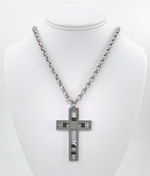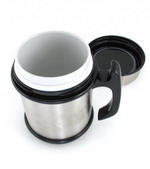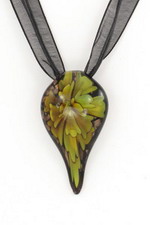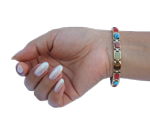Magnetic Copper Bangles
Click here or go to the Bottom of the page.


* For US customers only (in order to keep international shipping cost low/free)
--> For a larger image or to Buy- Click on the one you like <--
Copper Bangle Bracelet Therapy & The Benefits of Copper
Helmar Dollwet, Ph.D., of the University of Akron, has studied the copper bangle bracelet connection and thinks traces of dissolved copper entering the body through the skin from a copper bangle bracelet may be the only way for many people to get the copper they need.
A study found patients wearing copper bangle bracelets absorbed an average of 13 milligrams of copper during a month. "This could bring many people into the recommended daily intake for copper (1.5 to 3 milligrams). Copper absorbed through the skin gets into circulation very efficiently-more so than most dietary copper." Superoxide Dismutase (SOD) is one of the body's own copper-dependent enzymes that reduce pain and inflammation. The body may use copper to make more of its own SOD.
Through a copper bangle bracelet highly electrical and thermal conductive activity, it is apparent that when absorbed by the body that copper can produce a similar form of relief achieved by applying heat to an affected area. Research has indicated that rheumatic sufferers may have a deficiency of copper in the body, causing muscular contraction. More recently it has been recognized that a number of copper requiring enzymes are necessary for the repair of tissues damaged by arthritis. Forms of copper and copper complexes studied in these enzyme systems were found to mimic these copper requiring enzymes. Therefore, copper wristbands can be highly effective in counteracting the effects of inflammatory conditions.
Magnetic Strength
| Our copper magnetic bangle bracelet designs contain 2 magnets or more. We have specified thicker stronger magnets for our bracelets. Each magnet has factory graded strength of between 13700 to 14300 gauss. After capping the surface reading is between 1600 to 1800 gauss in strength. For this type of bracelet, probably one of the strongest available. |
Type of Magnets & Magnetic Life Expectancy
| Our Bangles contain Neodymium high strength magnets. The magnets are capped and then coated for extra protection. Under normal conditions neodymium magnets last for many decades, the magnets do not need to be recharged in any way. Magnets are bio north to the skin. |
Care of Your Copper Bangle
| The Copper will leave a green/black residue on the skin. This is good and indicates that the copper is being absorbed successfully. It can be easily washed off with soapy water. |
Sizing
The bangles adjust to fit a wrist in the size range 6 inches to 8 inches approximately. In a few designs we have an extra large size for wrists greater than 8 ½ inches. |
Click here so see Copper Bangles Selection ![]() or continue reading
or continue reading
----------------------------------------------------------------------------------------------
More about The Benefits of Copper and Copper Bangles Bracelets
Copper is an essential trace mineral that facilitates the activity of several enzymes. The mineral provides a role in the development and maintenance of the cardiovascular system, including the heart, arteries, and other blood vessels, the skeletal system, and the structure and function of the nervous system, including the brain.
The highest concentration of copper is found in the brain and liver. Copper is found in all other tissues in varying amounts, and about 50 percent of the total copper content of the body is found in the bones and muscles.
METHOD OF ACTION
Copper is involved in respiration and the synthesis of hemoglobin. It is essential in the production of collagen and the neurotransmitter noradrenalin. It is an important blood antioxidant and prevents the rancidity of polyunsaturated fats.
Copper is involved in numerous enzyme systems that break down or build up body tissues. It plays a role in the production of the skin pigment melanin by converting the amino acid tyrosine. The mineral is essential for the synthesis of phospholipids, which are a component of the myelin sheath that surrounds nerves.
Absorption of copper takes place in the stomach and upper intestine. Approximately 30 percent of ingested copper is absorbed. Copper influences iron absorption and mobilization from the liver and other tissue stores. Absorption of the mineral is increased by acids and inhibited by calcium (Kirschmann, 1996).
PROPERTIES & USES
Copper is used in the treatment of anemia because it works with iron in the development and maintenance of red blood cells and their protein hemoglobin.
Copper may provide benefit against pollution exposure and possibly protect against carcinogenesis and tumor growth. While this action is unproven in humans, animal studies have shown that copper may protect against chemically induced cancers and some RNA viruses (Kirschmann, 1996).
Wearing copper bangles is a long-term folk remedy for arthritis. While this information is controversial, a double-blind study in Australia concluded that copper bracelets reduced pain and inflammation. The hypothesis is that copper is absorbed through the skin and chelated to another compound that exerts and anti-inflammatory action. Copper is part of ceruloplasmin and SOD (superoxide dismutase), compounds that have antioxidant activity that may contribute benefits to the treatment of arthritis (Murray, 1996).
CARDIOVASCULAR DISEASE
Copper deficiency may play a role in atherosclerosis and aortic aneurysms. The exact mechanism is unknown, but studies shows that a copper deficiency or a high zinc intake resulting in deficiency of copper result in increased blood cholesterol levels, heart and arterial damage and increased mortality.
Copper deficiency may influence the development of aortic aneurysms because of the mineral’s role in cross-linking collagen and elastin fibers. The aorta and other arteries are surrounded by elastin fibers consisting of collagen and copper is essential to maintain their integrity. Supplementing with high doses of copper may increase the damaging oxidation of LDL cholesterol and is not recommended (Murray, 1996; Somer, 1995).

















































































